
Ah summertime has come. It’s time for lots of outdoor activities and, if you know the right places to go, hot air balloon festivals. Such balloon-launching events are well worth going to see. The colors, the shapes, the characters, etc. fill the sky with a display you seldom see. It’s only natural to pull out a camera for some photos. Today we’re talking about how to photograph hot air balloons.
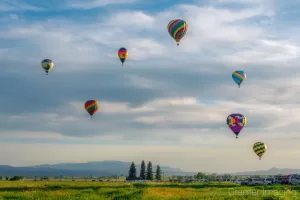
The first thing to note about hot air balloons is that they are more delicate than they seem. All that canvas can be damaged in strong winds. This means hot air balloons are only launched when the air is relatively still: cool summer mornings (best chances for optimal conditions). Balloon launches can happen during other times of day so adjust accordingly. Light winds allow the balloons to travel but strong winds yield dangerous conditions and necessitate much larger landing areas for balloonists. Rain and other poor weather conditions are also dangerous for balloons and balloonists. If poor weather is expected, then balloon launches are cancelled. Safety is a always top priority.
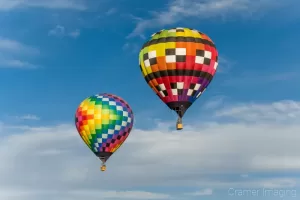
This means you need to get up early to see a hot balloon launch. Make sure that you get a good night’s sleep and bundle up a bit as even summer mornings can be a bit on the nippy side.
 Hot air balloons may be considered a sport but it’s a slow-moving sport. This means that you have plenty of time to get your shot in. You don’t have to worry about many things which other sports photography requires. I find that handholding your camera is best for photographing hot air balloons (I’ve tried tripod and it was too restrictive). This means you won’t require much in the way of extra gear.
Hot air balloons may be considered a sport but it’s a slow-moving sport. This means that you have plenty of time to get your shot in. You don’t have to worry about many things which other sports photography requires. I find that handholding your camera is best for photographing hot air balloons (I’ve tried tripod and it was too restrictive). This means you won’t require much in the way of extra gear.
You’ll need your camera body and a couple lenses. Take a wide angle lens for the earlier portion of the launch. Hot air balloons are big and wide angle lenses are the best way to capture the earlier part of a balloon launch. As the balloons fly off, you might consider switching to a telephoto lens to capture bigger photos of the balloons in the sky. Telephoto lenses are also handy as the balloons drift away on the wind. The further away the balloons go, the more you’ll want your telephoto lens to continue your photography.
Make sure that you have at least one fully charged battery with you. Also, take a polarizing filter as it can help cut glare and return the sky to a proper blue color if you’re standing facing the sun.
When photographing hot air balloons, you’ll want to think about your camera settings. Thanks to lots of available ambient light, you won’t need a high ISO. You can stay relatively low and be just fine. You might want to vary your aperture settings between wide and narrow depending upon the shot you want. I generally keep my aperture stopped down a ways as I want a greater depth of field allowing me to put more than one balloon in focus at a time. Your shutter speed can be mid-range to relatively fast depending upon your exact lighting conditions. In fact, I’d let my camera do lots of that work for me with Aperture Priority Mode. Still, that’s your choice as a photographer.

Due to hot air ballooning weather requirements, you’ll often find yourself shooting in harsh direct sunlight. Sometimes there will be clouds. You might get lucky and have enough clouds for decently soft and diffuse light. However, don’t count on such luck. Be prepared to shoot in direct sunlight and own it.
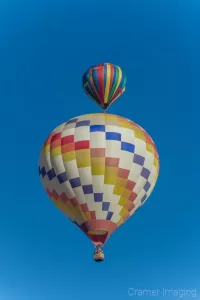
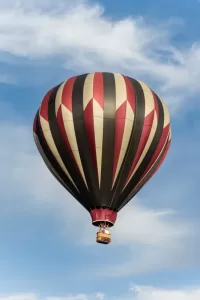
As a photographer, you want to know the parts of a balloon launch so that you know when to capture the balloons. The four main parts of the launch are the inflation, the launch itself, flying, and landing. We’ll cover each portion for your convenience. Also, keep in mind that each balloon will reach each stage on its own timetable. You may see balloons at different stages at the same time.
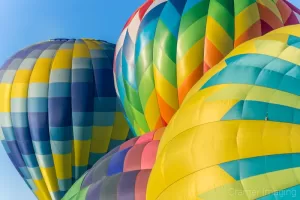
This portion of the launch is perhaps the longest and also perhaps the most boring. You will find yourself standing around a lot waiting for the balloon crews to roll out the balloons and start inflating them with hot air. Even with their propane burners, it’ll still take quite a while to warm enough air and properly inflate the balloon enough for liftoff. Stay out of the way and let the crews do their job.

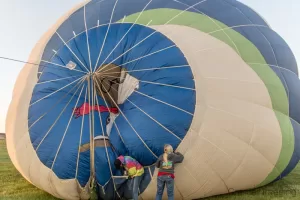
You’ll get to watch the balloons slowly come to life. This is also when you can get a good look at the tops of the balloons. You might find a surprise such as Snoopy looking at you (observe the photo above).
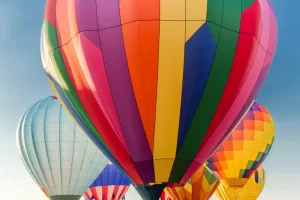
Take time to capture the balloons as they are inflating. There are plenty of different angles you can capture as you walk the launching field. As the balloons inflate, your photo opportunities will multiply and become more interesting. Your earlier patience will be rewarded.
Eventually some of the balloons will contain enough hot air to lift off the ground. It’s quite and exciting moment.

Launching is when you have a more compressed timetable. If you want to capture certain kinds of shots, such as layered balloon clusters, then you must be more on your feet. Balloons rise faster than you might think for such a slow-moving sport. In a couple minutes, a balloon rises several hundred feet into the air.
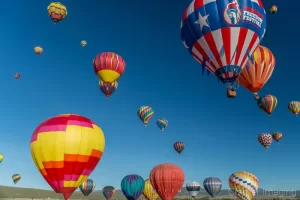
Once most of the balloons have launched, then you will turn your attention to getting photos of hot air balloons flying. Many times, this extended window of time can yield some very creative photos. Don’t worry about balloons being partially obscured by others in group shots. Such composition works well.
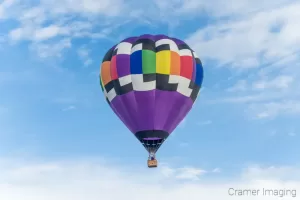

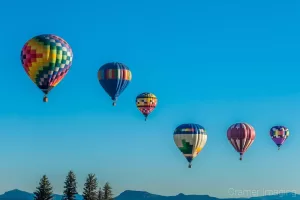
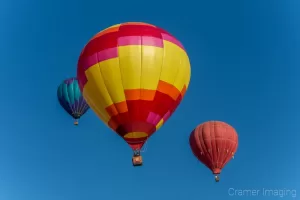
Try for some traditional shots and try for some other kinds of photos too. You should have plenty of time to experiment a bit. See if you can incorporate some of the surrounding landscape into your frame as it adds lots of color to the shot.

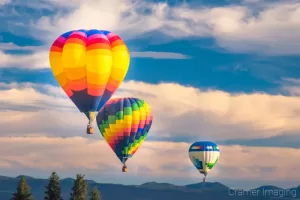
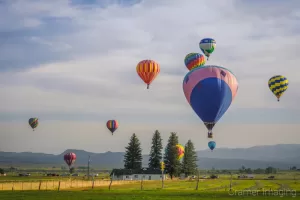
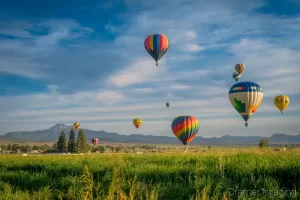
Don’t worry if your surrounding landscape could better be described as “cityscape.” Those kinds of hot air balloon photos work well too.
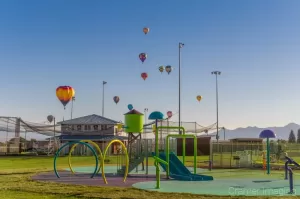
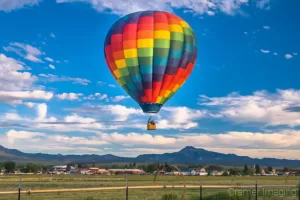
If you can capture photos of hot air balloons reflecting in a body of water, you’ve really got an opportunity. Capitalize on that opportunity. Not every photographer will see such and not every launch site will offer such an opportunity.

Don’t be surprised if you shoot more photos during the balloon flying stage. I often do. Things change much more dramatically when the balloons are in flight.
All good things must come to an end. This applies to hot air balloons too. Also, what comes up must come down. Eventually, those balloons will all land. While you cannot predict when or where the balloons will land, you can sometimes get a landing photograph without balloon chasing yourself.

Balloonists will sometimes need to land and launch again for one reason or another. If that happens, then you have a chance to capture the landing and the second launch.
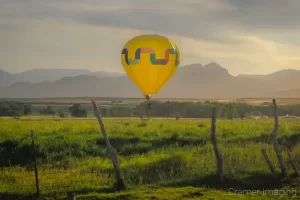
You may see several false starts at hot air balloons landing. Balloonists don’t want to risk themselves, their passengers, or their balloons on landing in the wrong place. If it doesn’t feel right or adequate, the balloon will rise up for another attempt.
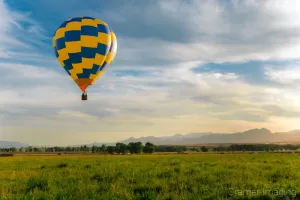
Once a balloon lands, the crew is not far behind to pack up the balloon and basket/gondola. If you want to capture landing photos, you’ll need to be quick. Balloons deflate much quicker than they inflate.
Once you’ve bagged some traditional photos of balloons launching and balloons in flight, you may find yourself searching for something new to try. Here are a few opportunities which you’ll need to check out for yourself at your event location as each event is different. However, at least one option listed below should present itself as available to you.
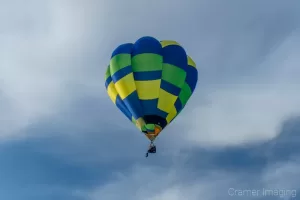
Keep your eyes open for interesting and special opportunities which might crop up at any time on your photo shoot. You might see interesting celestial bodies, for example, or planes flying by at much higher altitudes. If such an opportunity arises, capitalize on it if you can. You might end up with an interesting and unusual hot air balloon photo because of it.
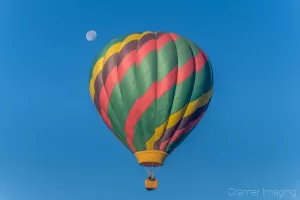
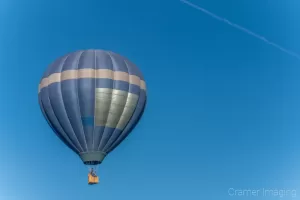
Hot air balloon launches and other activities easily lend themselves towards panoramas. There’s so much to capture that you could easily capture the angle with a panorama. Many photographers eventually approach hot air balloon launches with a panorama in mind. It’s the best way to capture everything you see and nothing else unnecessary in the process.
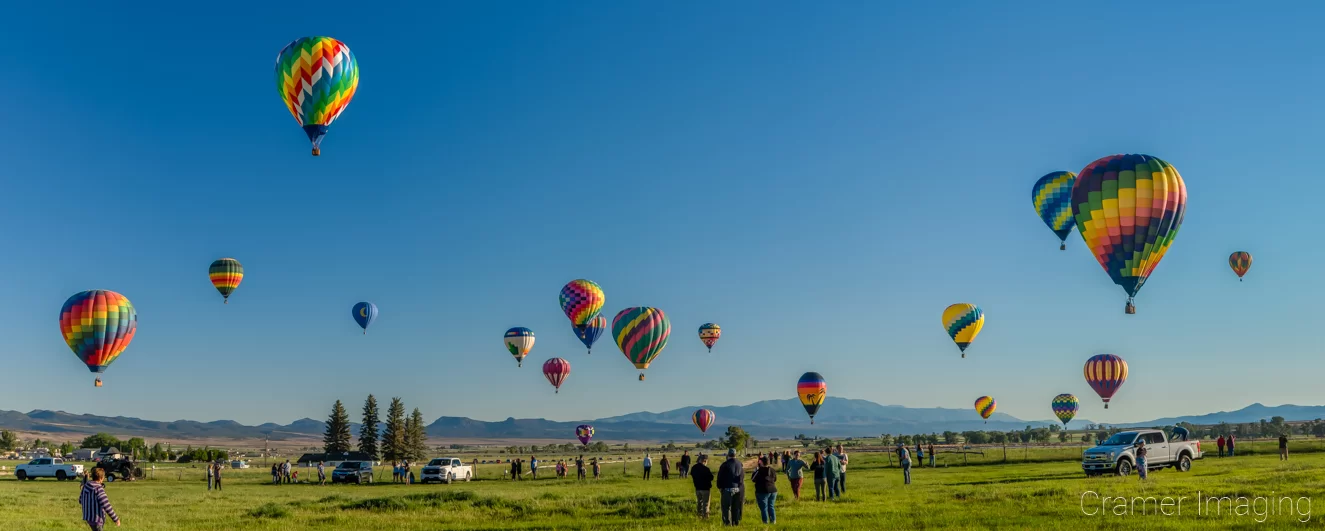
You’ll need to take several photos and later stitch them together using software if you want to take a panorama. Seek out a tutorial to teach you how to do this if you don’t already know how. Use tips like this to help with your panoramas.
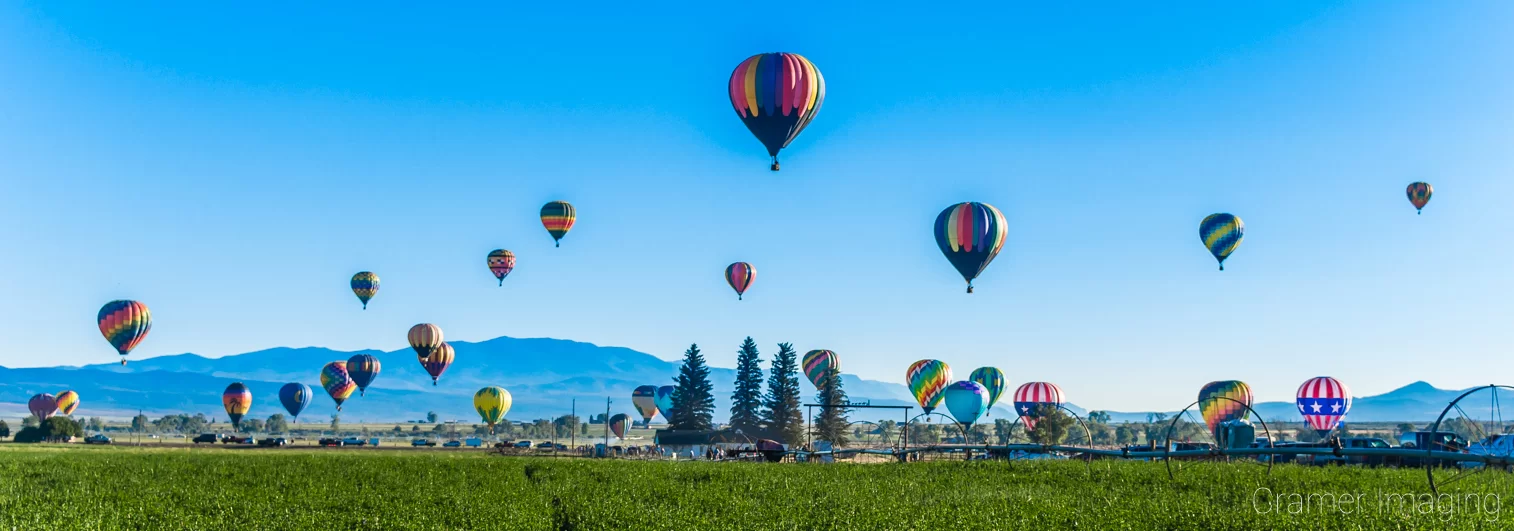
You may find panoramas are your best choice for shooting photos of balloons in flight. When in flight, balloons tend to fly at different elevations creating different layers in your photo. Panoramas capture the wide sweeping angle of multiple balloons in flight at the same time without sacrificing photo quality. Consider this approach if you want to try something new and different with these balloons.
If you have the chance to shoot hot air balloons from the air, take it. Most people don’t get to see this perspective of hot air balloons. If you have a drone, fly in a plane or helicopter, or even take a ride in a balloon, you can take some amazing photos from that point of view. If you have a drone, don’t interfere with the balloons. Keep your drone out of the way.
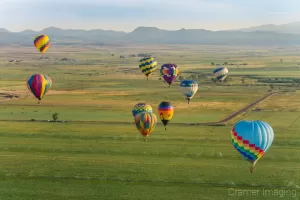
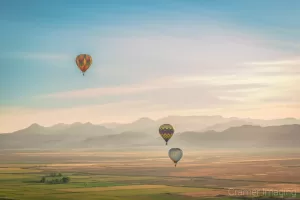
You’ll find riding in a hot air balloon to be a surprisingly stable shooting platform. However, once you think about it, it makes sense. You’re traveling at the speed of the wind so you won’t feel the wind at all. There’s not a lot of room to move around and the balloonist wants to keep things balanced so you won’t be bouncing. Just keep a really good grip on your camera AND use a neck strap. You really don’t want to accidentally drop your camera.
Some hot air balloon festivals include more than a simple morning/evening balloon launch. If that’s the case for the event you attend, then you have extra opportunities for hot air balloon photos.
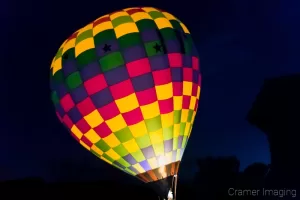
One event I’ve attended holds an evening balloon glow/candle-lighting event the day they launch the balloons. Most years, it’s too windy to inflate the balloons so all you get to see are the propane burners light up. That’s a spectacular show. Sometimes the balloon teams let children and other observers set off the propane jets. However, if the winds are calm, then the balloons go up and you can see them glow every time the balloonist releases a jet blast of propane fire.
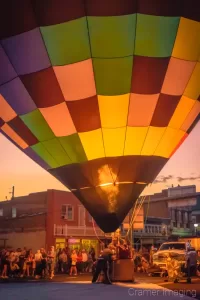
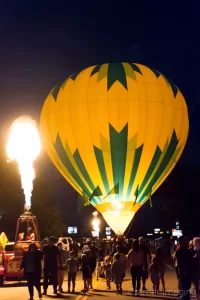
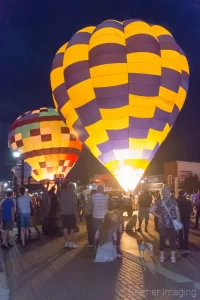
You need careful and precise timing to capture photos like this when the jets of flame work their magic. However, you’ll get the timing after a few attempts. Usually propane blasts come in groups or clusters, especially with an inflated balloon. If you get lucky and can capture a candle light with a balloon glow light at the same time, you’ve captured something golden.
Post-processing is the final part of the hot air balloon photography experience. Thankfully, there’s little to worry about here. You’re mainly worried about making sure that the balloon colors are bright and crisp. If you need to increase saturation a bit, then do so. Also, make sure that the photo(s) is/are properly sharp. Take some time to make sure the skies are properly blue (depending upon your photo) as blue skies are important. Make sure that you open shadows and reduce highlights if the range is too extreme. That should be the worst of you post-processing needs.
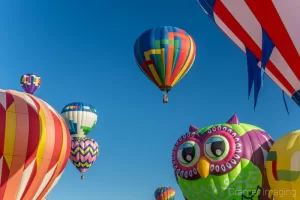
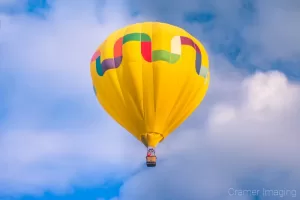
Photographing hot air balloons is rather laid-back and enjoyable. You can easily do so with minimal equipment and hand-holding. If you stay on your toes, you can walk away with some beautiful and creative photos. Post-processing should be quick and easy. Hot air balloon photos are a great addition to any photographer’s portfolio.
My final words of advice don’t concern actual photography. If you’re interested in shooting hot air balloons, look into when and where your nearest event is. Then make plans. Book your reservations ahead if you need to. Hotels fill up quickly months out at my closest balloonfest. Hope to see you out on the field too.


Receive monthly updates in your inbox from us.

Join our email-only photo of the week club to get the full stories behind how we captured our favorite fine art landscape photos.
We respect your privacy
No More Results